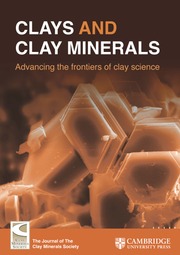Crossref Citations
This article has been cited by the following publications. This list is generated based on data provided by
Crossref.
Nagano, T.
Nakashima, S.
Nakayama, S.
Osada, K.
and
Senoo, M.
1992.
Color Variations Associated with Rapid Formation of Goethite from Proto-Ferrihydrite at pH 13 and 40°C.
Clays and Clay Minerals,
Vol. 40,
Issue. 5,
p.
600.
Charlet, Laurent
and
Manceau, Alain A
1992.
X-ray absorption spectroscopic study of the sorption of Cr(III) at the oxide-water interface.
Journal of Colloid and Interface Science,
Vol. 148,
Issue. 2,
p.
443.
Puls, Robert W.
Clark, Donald A.
Paul, Cynthia J.
and
Vardy, Jim
1994.
Transport and transformation of hexavalent chromium through soils and into ground water.
Journal of Soil Contamination,
Vol. 3,
Issue. 2,
p.
203.
Amonette, J. E.
Khan, F. A.
Scott, A.D.
Gan, H.
and
Stucki, J. W.
1994.
Quantitative Methods in Soil Mineralogy.
p.
83.
Buerge, Ignaz J.
and
Hug, Stephan J.
1999.
Influence of Mineral Surfaces on Chromium(VI) Reduction by Iron(II).
Environmental Science & Technology,
Vol. 33,
Issue. 23,
p.
4285.
Luptáková, V.
Sitek, J.
and
Tóth, I.
1999.
Interaction of Montmorillonite with Maltol.
Journal of inclusion phenomena and macrocyclic chemistry,
Vol. 34,
Issue. 1,
p.
97.
Chua-anusorn, Wanida
and
Webb, John
2000.
Infrared spectroscopic studies of nanoscale iron oxide deposits isolated from human thalassemic tissues.
Journal of Inorganic Biochemistry,
Vol. 79,
Issue. 1-4,
p.
303.
Taylor, Robert W.
Shen, Siyuan
Bleam, William F.
and
Tu, Shu-I
2000.
Chromate Removal by Dithionite-Reduced Clays: Evidence from Direct X-Ray Adsorption Near Edge Spectroscopy (XANES) of Chromate Reduction at Clay Surfaces.
Clays and Clay Minerals,
Vol. 48,
Issue. 6,
p.
648.
Dombrowski, T.
2000.
Kirk-Othmer Encyclopedia of Chemical Technology.
Loyaux-Lawniczak, Stéphanie
Refait, Philippe
Ehrhardt, Jean-Jacques
Lecomte, Paul
and
Génin, Jean-Marie R.
2000.
Trapping of Cr by Formation of Ferrihydrite during the Reduction of Chromate Ions by Fe(II)−Fe(III) Hydroxysalt Green Rusts.
Environmental Science & Technology,
Vol. 34,
Issue. 3,
p.
438.
Amonette, James E.
2002.
Soil Mineralogy with Environmental Applications.
Vol. 7,
Issue. ,
p.
153.
Paul, Cynthia J.
Khan, Faruque A.
and
Puls, Robert W.
2003.
Handbook of Groundwater Remediation using Permeable Reactive Barriers.
p.
465.
Zhu, Chen
2004.
Coprecipitation in the barite isostructural family: 1. binary mixing properties.
Geochimica et Cosmochimica Acta,
Vol. 68,
Issue. 16,
p.
3327.
Oze, Christopher
Fendorf, Scott
Bird, Dennis K.
and
Coleman, Robert G.
2004.
Chromium Geochemistry of Serpentine Soils.
International Geology Review,
Vol. 46,
Issue. 2,
p.
97.
Parga, J.R.
Cocke, D. L.
Valverde, V.
Gomes, J. A. G.
Kesmez, M.
Moreno, H.
Weir, M.
and
Mencer, D.
2005.
Characterization of Electrocoagulation for Removal of Chromium and Arsenic.
Chemical Engineering & Technology,
Vol. 28,
Issue. 5,
p.
605.
Su, Chunming
and
Ludwig, Ralph D.
2005.
Treatment of Hexavalent Chromium in Chromite Ore Processing Solid Waste Using a Mixed Reductant Solution of Ferrous Sulfate and Sodium Dithionite.
Environmental Science & Technology,
Vol. 39,
Issue. 16,
p.
6208.
Martin, Stacin
Zhu, Chen
Rule, Joseph
Nuhfer, Noel T.
Ford, Robert
Hedges, Sheila
and
Soong, Yee
2005.
A high-resolution TEM-AEM, pH titration, and modeling study of Zn2+ coprecipitation with ferrihydrite.
Geochimica et Cosmochimica Acta,
Vol. 69,
Issue. 6,
p.
1543.
Boily, Jean-François
Szanyi, János
and
Felmy, Andrew R.
2006.
A combined FTIR and TPD study on the bulk and surface dehydroxylation and decarbonation of synthetic goethite.
Geochimica et Cosmochimica Acta,
Vol. 70,
Issue. 14,
p.
3613.
Eary, L. Edmond
and
Davis, Andy
2007.
Geochemistry of an acidic chromium sulfate plume.
Applied Geochemistry,
Vol. 22,
Issue. 2,
p.
357.
Gulley-Stahl, Heather J.
Schmidt, Whitney L.
and
Bullen, Heather A.
2008.
Characterization and reactivity of chromia nanoparticles prepared by urea forced hydrolysis.
Journal of Materials Science,
Vol. 43,
Issue. 22,
p.
7066.

